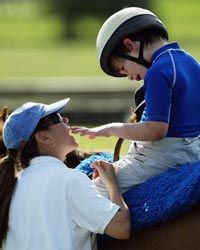Your happy, healthy baby seems to be right on track with his development. Then you enter the toddler years, and something seems different. Maybe he's not speaking or trying to verbalize the way other children do. Or he refuses to socialize, shutting himself off from contact with others. Maybe he becomes fixated on an object or activity and repeats it an abnormal number of times. You take your child to the doctor, and after a battery of tests, questionnaires and assessments, the doctor comes up with a diagnosis of Pervasive Developmental Disorder. What exactly does that mean?
Pervasive Developmental Disorders (also referred to as PDDs) are a category of developmental conditions that can affect children during the crucial stages of early development. A child with a PDD has some kind of delay in the formation of his behavior and communication skills. PDDs affect a person's basic skills such as speech, socialization and imagination. Although children may have symptoms of PDD at a very early age, they may not be truly noticeable until around age three, when it's more obvious that a child is not developing language or socialization skills at the same rate as others in his age bracket. Boys tend to develop PDDs more often than girls.
Advertisement
Because PDDs affect a child's behavior and communication, social and cognitive skills, some experts feel the label "pervasive" may be misleading. The term means "to become spread throughout all parts of," and while the child with PDD doesn't have fully pervaded development, it doesn't mean that every child with PDD has greatly retarded development, either. Nor does it mean that the disorder affects every aspect of a child's development. Some children may be severely affected by their PDD, but in others, it can be barely noticeable [Source: Dictionary.com, WebMD]. There are no cures for PDDs, but people with one may benefit from medication, therapy or both.
Five types of diagnoses fall into the PDD category, and each type of disorder can range from mild to severe, depending on the child. On the next pages, we'll look at these five PDDs and their characteristics.
Advertisement




